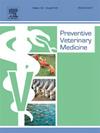The resilience of the Dutch pork supply chain to Toxoplasma gondii
IF 2.2
2区 农林科学
Q1 VETERINARY SCIENCES
引用次数: 0
Abstract
Toxoplasma gondii (T. gondii) is a parasite leading to a substantial disease burden. An important source of toxoplasmosis is raw or undercooked pork. Our aim is to develop a model that can assess the resilience of the Dutch pork supply chain to T. gondii shocks, measured in Disability adjusted life years (DALYs), and the cost-effectiveness ratio (CER) of control measures that improve the resilience of the supply chain. We developed a farm-to-fork model to simulate T. gondii through the pork supply chain. We modelled two shocks: 1) young cats on the farm, a long-term shock, and 2) feeding pigs a batch of contaminated goat whey, a short-term shock, and two control measures: 1) sterilising cats at farm level, and 2) freezing meat at processing level. When facing shock 1, all control measures can be considered cost-effective with a CER between k€3 and k€24 per DALY in the first year and between k€1 and k€13 per DALY in subsequent years. When facing shock 2, freezing unheated meat, or freezing unheated meat and large pork cuts, or freezing all pork products led to a CER of respectively k€21, k€10, and k€46 per DALY in the first year. However, in subsequent years, the CER ranged from k€162 to k€820 per DALY, which cannot be considered cost-effective anymore. Control measures are more cost-effective in case of a long-term shock than in case of an isolated short-term shock. In the latter case, a control measure can be cost-effective if applied only for a limited time after the shock has been detected. The developed model can be used by decision makers to select effective control measures against toxoplasmosis caused by pork consumption.
荷兰猪肉供应链对刚地弓形虫的抵御能力。
刚地弓形虫(弓形虫)是一种导致重大疾病负担的寄生虫。弓形虫病的一个重要来源是生猪肉或未煮熟的猪肉。我们的目标是开发一个模型,可以评估荷兰猪肉供应链对弓形虫冲击的弹性,以残疾调整生命年(DALYs)和提高供应链弹性的控制措施的成本效益比(CER)来衡量。我们开发了一个从农场到餐桌的模型来模拟弓形虫在猪肉供应链中的传播。我们模拟了两种冲击:1)农场的幼猫,长期冲击;2)给猪喂一批受污染的山羊乳清,短期冲击;以及两种控制措施:1)农场层面对猫进行消毒,2)加工层面对肉进行冷冻。当面临冲击1时,所有控制措施都可以被认为是具有成本效益的,第一年的CER在每DALY 3欧元至24欧元之间,随后几年的CER在每DALY 1欧元至13欧元之间。当面临冲击2时,冷冻未加热的肉类,或冷冻未加热的肉类和大块猪肉,或冷冻所有猪肉产品,第一年的CER分别为每DALY 21欧元,10欧元和46欧元。然而,在随后的几年里,每个DALY的CER从162欧元到820欧元不等,不再被认为具有成本效益。控制措施在长期冲击情况下比在孤立的短期冲击情况下更具成本效益。在后一种情况下,如果仅在检测到冲击后的有限时间内应用控制措施,则具有成本效益。所建立的模型可为决策者选择有效的猪肉消费弓形虫病控制措施提供依据。
本文章由计算机程序翻译,如有差异,请以英文原文为准。
求助全文
约1分钟内获得全文
求助全文
来源期刊

Preventive veterinary medicine
农林科学-兽医学
CiteScore
5.60
自引率
7.70%
发文量
184
审稿时长
3 months
期刊介绍:
Preventive Veterinary Medicine is one of the leading international resources for scientific reports on animal health programs and preventive veterinary medicine. The journal follows the guidelines for standardizing and strengthening the reporting of biomedical research which are available from the CONSORT, MOOSE, PRISMA, REFLECT, STARD, and STROBE statements. The journal focuses on:
Epidemiology of health events relevant to domestic and wild animals;
Economic impacts of epidemic and endemic animal and zoonotic diseases;
Latest methods and approaches in veterinary epidemiology;
Disease and infection control or eradication measures;
The "One Health" concept and the relationships between veterinary medicine, human health, animal-production systems, and the environment;
Development of new techniques in surveillance systems and diagnosis;
Evaluation and control of diseases in animal populations.
 求助内容:
求助内容: 应助结果提醒方式:
应助结果提醒方式:


